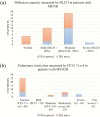Pulmonary Function in Patients With Multiple Endocrine Neoplasia 2B
- PMID: 32448901
- PMCID: PMC7365699
- DOI: 10.1210/clinem/dgaa296
Pulmonary Function in Patients With Multiple Endocrine Neoplasia 2B
Abstract
Context: Multiple endocrine neoplasia type 2B (MEN2B) is a rare cancer predisposition syndrome resulting from an autosomal-dominant germline mutation of the RET proto-oncogene. No prior studies have investigated pulmonary function in patients with MEN2B.
Objective: This study characterized the pulmonary function of patients with MEN2B.
Design: This is a retrospective analysis of pulmonary function tests (PFTs) and chest imaging of patients enrolled in the Natural History Study of Children and Adults with MEN2A or MEN2B at the National Institutes of Health.
Results: Thirty-six patients with MEN2B (18 males, 18 females) were selected based on the availability of PFTs; 27 patients underwent at least 2 PFTs and imaging studies. Diffusion abnormalities were observed in 94% (33/35) of the patients, with 63% (22/35) having moderate to severe defects. A declining trend in diffusion capacity was seen over time, with an estimated slope of -2.9% per year (P = 0.0001). Restrictive and obstructive abnormalities were observed in 57% (20/35) and 39% (14/36), respectively. Computed tomography imaging revealed pulmonary thin-walled cavities (lung cysts) in 28% (9/32) of patients and metastatic lung disease in 34% (11/32) of patients; patients with metastatic lung lesions also tended to have thin-walled cavities (P = 0.035).
Conclusions: This study characterized pulmonary function within a MEN2B cohort. Diffusion, restrictive, and obstructive abnormalities were evident, and lung cysts were present in 28% of patients. Further research is required to determine the mechanism of the atypical pulmonary features observed in this cohort.
Keywords: MEN2B; diffusion capacity; lung cysts; pulmonary function.
Published by Oxford University Press on behalf of the Endocrine Society 2020.
Figures



Similar articles
-
Early diagnosis of multiple endocrine neoplasia type 2B: a challenge for physicians.Arq Bras Endocrinol Metabol. 2008 Nov;52(8):1393-8. doi: 10.1590/s0004-27302008000800031. Arq Bras Endocrinol Metabol. 2008. PMID: 19169500
-
RET proto-oncogene mutations are restricted to codons 634 and 918 in mainland Chinese families with MEN2A and MEN2B.Clin Endocrinol (Oxf). 2007 Oct;67(4):570-6. doi: 10.1111/j.1365-2265.2007.02927.x. Epub 2007 Jun 15. Clin Endocrinol (Oxf). 2007. PMID: 17573899
-
The Reality of Multiple Endocrine Neoplasia Type 2B Diagnosis: Awareness of Unique Physical Appearance Is Important.J Nippon Med Sch. 2018;85(3):178-182. doi: 10.1272/jnms.JNMS.2018_85-26. J Nippon Med Sch. 2018. PMID: 30135345
-
[Multiple endocrine neoplasia type IIb].Nihon Rinsho. 2006 Sep 28;Suppl 3:343-7. Nihon Rinsho. 2006. PMID: 17022560 Review. Japanese. No abstract available.
-
Hereditary Medullary Thyroid Cancer: Genotype-Phenotype Correlation.Recent Results Cancer Res. 2025;223:183-209. doi: 10.1007/978-3-031-80396-3_7. Recent Results Cancer Res. 2025. PMID: 40102258 Review.
References
-
- Castinetti F, Moley J, Mulligan L, Waguespack SG. A comprehensive review on MEN2B. Endocr Relat Cancer. 2018;25(2):T29-T39. - PubMed
-
- Dackiw AP, Kuerer HM, Clark OH. Current national health insurance policies for thyroid cancer prophylactic surgery in the United States. World J Surg. 2002;26(8):903-906. - PubMed
-
- Fagin JA, Wells SA Jr. Biologic and clinical perspectives on thyroid cancer. N Engl J Med. 2016;375(23):2307. - PubMed
-
- Carney JA, Bianco AJ Jr, Sizemore GW, Hayles AB. Multiple endocrine neoplasia with skeletal manifestations. J Bone Joint Surg Am. 1981;63(3):405-410. - PubMed

